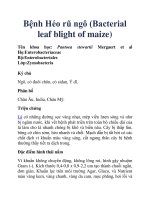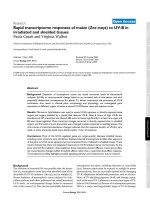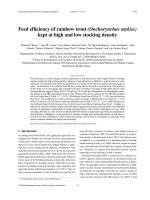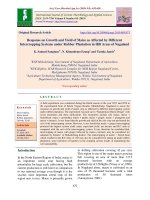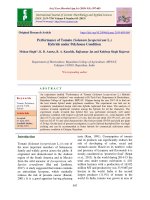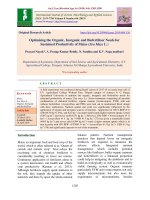Screening of maize doubled haploid derived hybrids at flowering stress and optimal condition
Bạn đang xem bản rút gọn của tài liệu. Xem và tải ngay bản đầy đủ của tài liệu tại đây (422.75 KB, 10 trang )
Int.J.Curr.Microbiol.App.Sci (2020) 9(5): 2620-2629
International Journal of Current Microbiology and Applied Sciences
ISSN: 2319-7706 Volume 9 Number 5 (2020)
Journal homepage:
Original Research Article
/>
Screening of Maize Doubled Haploid Derived Hybrids at
Flowering Stress and Optimal Condition
B. V. Ananda Kumar1*, S. R. Venkatachalam2, R. Ravikesavan3, P. Kathirvelan1,
S. Nackeeran1 and Venkatesh Selvarangam4
1
Centre for Plant Breeding and Genetics, Tamil Nadu Agricultural University,
Coimbatore, Tamil Nadu, India
2
Tapioca and Castor Research station, Tamil Nadu Agricultural University,
Yethapur, Tamil Nadu, India
3
Department of Millets, Department of Pathology, Centre for Plant Breeding and Genetics,
Tamil Nadu Agricultural University, Coimbatore, Tamil Nadu, India
4
Pioneer Hi-Bred Pvt. Ltd., Multi Crop Research Center,
Wargal, Hyderabad, Telangana, India
*Corresponding author
ABSTRACT
Keywords
Correlation
coefficient, Drought
susceptible index,
Drought, Top
crosses, Maize (Zea
mays L).
Article Info
Accepted:
18 April 2020
Available Online:
10 May 2020
Two field experiments were conducted at Hyderabad and Aurangabad in India
under water stress at flowering and well watered condition during the rabi season
(2018). The objective of the study was to assess the drought tolerance traits in
maize DHL’s x Tester (Top cross hybrids). Three hundred top crosses developed
from crossing between 150 DHL’s and tester from heterotic group A similarly
another 150 DHL’s and tester from heterotic group B along with four checks were
evaluated under two watering treatments, i.e. well watering (WW) and water stress
at flowering (WSF) using augmented complete block design. The effect due to
genotypes x location was highly significant for all drought tolerance parameters
studied. The drought stress at flowering stages of maize results in a drastic
reduction in grain yield by 41.34 percent when compared to optimal condition.DSI
had a significant and negative correlation coefficient with grain yield (-0.852),
chlorophyll content (-0.622), ear height (-0.348) and plant height (-0.253) under
WSF condition. Moreover, DSI had bigger in-magnitude, but highly significant
and positive correlation coefficient with days ASI (0.745) tassel sterility (0.785)
and tassel blast (0.771). Therefore, based on drought susceptible index, the top 34
hybrids have been shortlisted.The secondary drought traits play an important role
which could be used for selection and improving grain yield and facilitate further
efforts in maize breeding programs.
2620
Int.J.Curr.Microbiol.App.Sci (2020) 9(5): 2620-2629
Introduction
Drought is one of the most detrimental abiotic
stresses across the world which is seriously
hampering the productivity of agricultural
crops. Water scarcity is the most important
environmental limiting factor for maize
productivity in tropical and subtropical
regions (Messmer etal.2011). Maize is among
the leading cereal crops in world, but it is
sensitive to drought. Maize is affected by
drought at different growth stages in different
regions. Drought stress at seedling and
flowering stages of maize has been estimated
to cause annual yield losses of about 13% in
the tropics (Edmeades et al., 1993). When
drought stress occurs before or during
flowering in maize, a delay in silk emergence
is observed, resulting in an increase in
anthesis-silking interval (ASI) (Hall et al.,
1982).
Moisture stress affects crop yield by reducing
the plant stand, leaf area and photosynthesis
rate during pre-flowering period, ear and
kernel set during flowering and by inducing
early leaf senescence during grain filling
stage. Additional yield reduction may be due
to increased energy and nutrient consumption
of drought adaptive responses, such as
enhanced root growth (Zhan et al., 2015). In
India, though breeding work on maize
drought resistance is being operative since
many years, the present day hybrids available
in public and private sector need to be
improved for drought tolerance with stable
yield levels.
It has been found that, a complex physiogenetic mechanism highly influenced by
environment exists for drought response in
maize. In this regard, there is a need to
develop maize hybrids with enhanced
tolerance to drought situation with stable
yield levels across different environments.
The main objective of this study was to screen
maize hybrids for tolerance to moisture stress
at flowering at two maize growing areas of
south India where water scarcity occurs
frequently.
Materials and Methods
Population development
Based on preliminary germplasm evaluation
study of CIMMYT lines ( from IMIC- Asia)
carried out by Ananda Kumar B V (Research
Scientist Pioneer Hi-Bred Private limited)
(Unpublished) Six inbred lines viz.,
ZL113812,
ZL135133,
ZL135154,
ZL113908, ZL135137 and ZL135158 with
relatively drought tolerant lines were
identified based on the phenotyping data.
During Rainy 2016 the three inbreds
ZL113812, ZL135133 and ZL135154 were
crossed to known tester CML479 (Neutral for
drought) and ZL113908, ZL135137 and
ZL135158 were crossed to known tester
CML451 (Neutral for drought) to develop
breeding crosses within heterotic group.
The developed six single crosses ZL113812 X
CML459, ZL135133 X CML459, ZL135154
X CML479, ZL113908 X CML451,
ZL135137 X CML451 and ZL135158 X
CML451 were subjected to production of
double haploid lines at Pioneer Hi-Bred
private limited facility Bangalore and
developed 50 DHL’s from each population.
During Rainy 2018 all the DHL’s (300) were
crossed to opposite heterotic group testers
(CML 451 and CML 478) to get 300 hybrids.
Evaluation of hybrids
Three hundred hybrids along with competitive
and relatively stress tolerant check hybrids
viz., P3401, P3550, DKPDKC 9133,
EUAS6668 were planted under normal wellwatered (WW) and water stress at flowering
condition (WSF) was considered to screen for
2621
Int.J.Curr.Microbiol.App.Sci (2020) 9(5): 2620-2629
moisture stress tolerance by following
Augmented complete block design during PR
2018. The experimental material was grown
in two separate sets in two different locations
viz, Hyderabad, Telangana (lat. 170.46 N,
long. 780.46 E) and Aurangabad, Maharastra
(lat. 190.72 N, long. 750.20 E) which are
under the control of Pioneer Hi-Bred Pvt Ltd.
One set was sown under moisture stress and
another set under normal conditions by
following 60 × 30 cm spacing and 100:50:25
kg ha-1 N:P:K.
Irrigation was given to both the sets up to
forty days after sowing with a regular interval
of seven to ten days. Moisture stress was
induced by withholding the irrigation between
55-75 DAS (i.e. during anthesis). To avoid
barren cobs and ensure optimum plant stand,
a protective irrigation was given at 75 days
after sowing whereas, normal field received
irrigation at an interval of seven to ten days,
till physiological maturity.
calculated from grain weight and percent
moisture. During seed setting stage the plant
height was measured from the base of the
randomly selected three plants at ground level
to the tip of the tassel, averaged and expressed
in centimeters (cm). The ear height was
measured from the base of the randomly
selected three plants at ground level to the
Base of the ear, averaged and expressed in
centimeters (cm). The relative chlorophyll
content of the third leaf from the top was
measured at 70 days after sowing (DAS) on
three randomly selected competitive plants
using chlorophyll meter (SPAD-502, Konica
Minolta make). The SPAD values were
recorded as the average value of chlorophyll
content at lower, upper and middle portion of
the leaf from each entry in both the
treatments. Drought susceptibility index was
computed as suggested by Fisher and Maurer
(1978) by considering the data of grain yield
under moisture stress and normal condition.
DSI = {1- (Ys / Yi)}/D
Field data recording
Data were recorded from each plot in both
WSF and WW blocks at Hyderabad and
Aurangabad in 2018. Days to 50 % anthesis
(DTA) and days to 50 % silking (DTS) were
recorded as the number of days from planting
to when 50 % of plants in a plot sheded
pollen, and had emerged silks, respectively.
Anthesis silking interval was computed as the
difference between DTS and DTA. Tassel
sterility was scored on a scale of 1–9 at peak
flowering stage, where 1 = all tassel branches
in the plot are fertile and 9 = all the tassel
branches are sterile.
Tassel blast was scored on a scale of 1–9 at
peak flowering stage, where 1 = all the tassels
on all plants in the plot are fertile and 9 = all
the tassels on all the plants in the plot are
dried up. Grain yield, measured in t ha-1
adjusted to 15 % moisture content was
Where, Ys- Grain yield of a genotype under
moisture stress environment Yi- Grain yield
of a genotype under normal environment
Statistical analysis
Analysis of variance (ANOVA) was
performed for each character using the
computer system WINDOSTAT (version 9.3
from Indostat), to reveal significant effects
among the genotypes and environment.
Analysis of variance was carried out for all
studied characters in each location separately
by using augmented design. Furthermore,
combined analysis of variance is given.
2622
Int.J.Curr.Microbiol.App.Sci (2020) 9(5): 2620-2629
Results and Discussion
Phenotypic correlation
drought tolerance traits
between
the
Mean performance of the hybrids
Combined analysis (Table 1) shows the
variability of the different drought tolerance
parameters. Highly significant differences
between genotypes (P≤ 0.01) were recorded
for all the traits except Anthesis silking
interval and Tassel sterility under WW
condition and significant differences between
genotypes (P≤ 0.01) were recorded for all the
traits under WSF.(Table 1).
The effect due to genotypes x location's
interaction showed
highly significant
differences for all the traits under WSF.
Highly significant differences observed for all
the traits except tassel sterility and tassel blast
for genotypes x location interaction under
WW condition. The performance of
genotypes was variable according to the
difference in time of incidence of drought
stress (Figure 1).
The highest grain yield under WSF condition
(7.82 t/ha) was achieved by the hybrid
(DHL’s x tester) H148, while the lowest grain
yield (0.49 kg/ha) was obtained by the
hybridH205 (Table 2). When there was no
stress induced during the (WW) the highest
grain yield (11.32 t/ha) was produced by
hybrid H64 and the lowest grain yield (4.27
t/ha) was obtained by genotype H201.
The drought susceptibility index (DSI) shows
that the most tolerant hybridsareH36 and H79
(0.48) and the most susceptible hybrid is
H205 (1.4). The numbers of topmost tolerant
hybrids based on DSI (Table 2) were 34 out
of 300 hybrids tested across locations when
compared to mean of check hybrids. Overall
the reduction of 41.34 percent yield and
reduced ASI for 5.27 days was also observed
in WSF when compared to WW condition
(Table 3).
The phenotypic correlations between the
studied drought tolerance traits under WSF
were exhibited in Table 4. The correlation for
grain yield was highly significant and
negative for DSI, ASI, Tassel sterility, Tassel
blast, while highly significant and positive
with chlorophyll content, ear height and plant
height. The correlation for DSI was highly
significant and positive with ASI, tassel
sterility, and tassel blast, while it was highly
significant and negative with grain yield,
plant height, ear height, and chlorophyll
content. There was positive and significant
correlation for ASI with tassel sterility and
tassel blast, but it was negative and significant
with chlorophyll content, ear height, plant
height, and grain yield. However, highly
significant negative correlation was found for
chlorophyll content with tassel sterility and
tassel blast (Table 4). The correlation between
ear height and plant height was significant
and positive whereas highly significant and
positive between tassel sterility and tassel
blast. Significant negative correlation was
found for plant height with tassel sterility and
tassel blast (Table 4).
Drought stresses affect's maize grain yield to
some degree at almost all growth stages
(Grant et al., 1989, Ahmed, 2002). Flowering
stage has been considered the most sensitive
stage accompanying with reduce pollen
production, pollen viability, tassel blasting
and prolong anthesis– silking interval (ASI)
under moisture stress (kumar et al., 2015).. In
this study, there were reductions in the
estimate of genetic variability of traits under
the water-stress treatments depending on the
severity of drought. The reduction of grain
yield was observed by 41.34 percent when
compared to optimal condition and ASI is
considered to be most important trait for
drought tolerance has reduced by 5.27 days
2623
Int.J.Curr.Microbiol.App.Sci (2020) 9(5): 2620-2629
which is also observed by Almeida et al.,
(2013) and Abuali et al., (2014). The effect
due to genotypes x location was highly
significant for all traits under study and
significant for grain yield and chlorophyll
content under WSF indicating that the genetic
variance in stress environment was more than
non-stress conditions (Hohls, 2001).
The highest yield was recorded for the hybrid
H148 under WSF and the top yielding hybrid
under WW was H64 similarly the least values
of DSI for hybridsH79 and H36 indicates that
the hybrids which are top yielding under WSF
are not same in WW condition and response
of genotypes to drought differs according to
their genetic structure and adaptability.
Wenzel (1999) reported that some genotypes
yielded more under moisture stress than under
near-ideal moisture conditions. Johnson and
Geadelmann (1989) reported that a low
genetic correlation was often observed to
yield
in
high-and
low-productivity
environments, indicating that unusual sets of
genes may be important, indicating the yield
in different environments.
Thirunavukkarasu et al., (2014) concluded
that phenotypic correlation coefficient
showed that grain yield and the traits
contributing to it were positively and
significantly correlated with each other, and
ASI was negatively but significantly
correlated with other agronomic traits similar
trend has been observed in the study. The
grain yield was positively correlated with
chlorophyll content, plant height and ear
height, indicating the importance of these
traits in selection for yield and grain yield was
negatively correlated with ASI and DSI.
Table.1 Mean squares from the analysis of variance due to genotypes (G) and
their interaction with locations (GxL) between 304 maize genotypes for all the traits
studied under WSF and WW condition
Drought Tolerance
DF
Anthesis silkinginterval WW
Anthesis silkinginterval WSF
Chlorophyll content WW
Chlorophyll content WSF
Ear height WW
Ear height WSF
Plant height WW
Plant height WSF
Tassel sterility WW
Tassel sterility WSF
Tassel blast WW
Tassel blast WSF
Grain Yield WW
Grain Yield WSF
Drought susceptibility index
*Significant at 5%
Genotypes
303
0.98
10.5**
74.57**
44.96**
173.42**
124.19**
275.82**
342.95**
0.03
7.41**
0.04**
7.29**
3.88**
3.54**
0.048**
** Significant at 1%
2624
GXL
303
89.29**
588.16**
528.95**
20.04*
373.75**
213.7**
817.5**
1339.6**
0.02
43.69**
0.006
127.11**
4.46*
3.85**
0.64**
Int.J.Curr.Microbiol.App.Sci (2020) 9(5): 2620-2629
Table.2 Means of drought tolerance traits of top 34 maize top cross hybrids evaluated at two water treatments across two locations
(Hyderabad and Aurangabad) during Rabi 2018
Hybrid
H79
H36
H12
H214
H29
H81
H63
H148
H77
H175
H180
H211
H94
H160
H14
H41
H245
H87
H16
H23
H190
H165
H70
H168
DSI
0.481
0.485
0.490
0.498
0.501
0.504
0.508
0.510
0.510
0.510
0.512
0.517
0.521
0.521
0.522
0.522
0.523
0.530
0.531
0.535
0.541
0.544
0.551
0.551
Grain Yield
(t/ha)
WW
10.22
9.12
9.02
8.87
8.87
9.77
9.77
10.75
9.62
9.62
9.67
8.57
9.42
9.47
8.47
8.47
8.47
9.27
8.42
8.27
9.07
9.02
11.00
8.92
WSF
7.29
6.19
6.09
5.94
5.94
6.84
6.84
7.82
6.69
6.69
6.74
5.64
6.49
6.54
5.54
5.54
5.54
6.34
5.49
5.34
6.14
6.09
7.34
5.99
ASI
WW
1.67
1.54
2.54
2.04
2.04
2.17
1.17
2.92
1.17
3.04
1.54
3.04
2.17
1.54
1.54
2.04
1.54
1.67
1.04
1.54
2.04
1.04
1.67
2.04
WSF
4.21
3.58
3.08
5.58
4.58
5.71
3.71
4.21
3.21
4.71
4.21
4.58
4.71
4.21
3.58
4.08
4.58
5.21
3.58
5.08
4.71
5.71
3.71
5.71
Chlorophyll
content (SPAD
values)
WW
WSF
37.10
25.66
36.90
32.37
44.90
26.92
31.30
27.32
49.45
27.97
43.70
25.96
41.75
25.91
40.06
28.97
52.20
28.01
29.45
26.41
39.80
28.31
51.95
25.87
34.15
29.36
38.45
29.06
39.50
33.17
30.10
26.37
53.10
31.32
44.20
27.41
36.30
24.77
51.00
34.27
37.00
22.06
31.85
21.51
35.90
26.81
31.50
23.56
Ear height
(cm)
WW
123.87
125.13
126.13
117.43
119.87
112.14
115.89
106.79
110.89
101.02
107.27
101.43
122.88
108.52
116.62
113.63
113.44
123.63
121.62
107.12
99.02
96.27
121.38
109.76
2625
WSF
108.63
105.00
99.49
106.98
102.24
101.87
109.13
100.64
93.87
94.87
96.37
95.50
95.38
105.37
116.49
112.74
103.74
105.62
99.25
102.74
95.02
88.86
111.88
98.38
Plant height
WW
198.48
230.51
234.01
211.51
227.01
200.98
195.98
211.52
198.48
189.73
187.73
216.26
214.73
188.48
220.26
216.01
211.26
214.48
232.76
210.76
197.72
185.48
196.47
191.48
WSF
191.64
213.94
198.69
180.94
178.44
204.90
181.65
178.42
186.65
176.15
168.65
180.44
188.40
177.65
182.44
207.69
185.94
177.65
178.44
204.19
164.90
181.39
192.40
176.90
Tassel sterility
(score)
WW
0.92
1.54
1.04
1.04
1.04
0.92
0.92
1.04
0.92
0.92
0.92
1.04
1.42
0.92
1.04
1.04
1.04
0.92
1.04
1.04
0.92
0.92
0.92
0.92
WSF
0.71
1.21
1.71
1.21
2.71
0.71
0.71
1.08
0.71
1.71
0.71
2.21
1.21
0.71
2.71
1.21
1.21
0.71
1.71
1.71
0.71
1.21
1.21
0.71
Tassel blast
(score)
WW
0.92
1.04
1.04
1.04
1.04
0.92
0.92
1.04
1.42
1.42
0.92
1.04
1.42
0.92
1.04
1.04
1.04
0.92
1.04
1.04
0.92
0.92
0.92
0.92
WSF
1.00
1.75
1.75
1.75
1.75
1.50
1.00
0.75
1.00
1.00
1.00
1.25
1.50
1.00
1.75
1.75
1.25
1.00
1.75
2.25
1.50
1.00
1.00
1.00
Int.J.Curr.Microbiol.App.Sci (2020) 9(5): 2620-2629
H4
H159
H111
H26
H153
H145
H181
H113
H34
H158
Check
Mean
0.551
0.553
0.554
0.554
0.555
0.557
0.557
0.557
0.557
0.559
0.56
8.02
8.92
10.05
7.97
9.39
9.85
8.82
9.80
8.07
8.82
9.08
5.09
5.99
7.12
5.04
6.29
6.92
5.89
6.87
5.14
5.89
6.08
1.54
1.54
2.42
2.04
1.54
1.92
1.54
3.42
2.04
2.54
2.42
4.08
6.21
5.21
4.58
5.21
5.71
6.71
5.71
4.58
5.71
3.96
28.40
26.35
42.26
38.50
35.45
33.46
32.95
53.86
30.50
31.05
42.32
29.47
22.16
28.72
26.12
27.71
29.82
18.26
28.62
26.32
26.46
31.28
115.63
119.02
123.29
104.62
102.78
116.80
107.02
108.54
110.88
106.01
116.37
117.99
110.88
113.14
101.99
92.38
111.64
98.38
97.38
104.23
97.87
112.62
222.76
210.73
220.77
221.01
193.48
212.78
197.97
224.03
199.01
178.48
210.45
226.44
203.65
186.92
172.44
183.40
183.42
200.65
185.67
173.44
182.90
194.75
1.04
0.92
1.04
1.04
1.42
1.04
0.92
1.04
1.04
0.92
1.04
2.21
1.21
2.08
2.71
1.71
2.08
1.21
1.08
2.21
2.21
1.96
1.04
0.92
1.04
1.04
0.92
1.04
0.92
1.04
1.04
0.92
1.17
Table.3 Effect of moisture stress on yield, its components traits and traits associated with moisture stress tolerance in maize hybrids
Traits
Grain yield (t/ha)
Anthesis silking interval
Chlorophyll content (SPAD Value)
Ear height (cm)
Plant height (cm)
Tassel sterility (score)
Tassel blast (score)
WW
WSF
7.27
2.26
36.37
110.83
206.23
1.03
1.04
4.26
7.53
21.70
98.79
182.66
4.16
3.84
2626
Difference Reduction
under stress
(%)
3.00
41.34
-5.27
14.67
40.34
12.04
10.86
23.57
11.43
-3.13
-2.80
-
Increase under
stress (%)
232.85
302.77
268.82
2.25
1.00
1.25
2.75
1.00
1.25
1.50
0.75
2.25
2.00
1.75
Int.J.Curr.Microbiol.App.Sci (2020) 9(5): 2620-2629
Table.4 Phenotypic coefficient of correlations between the different drought tolerance traits for
maize genotypes under two locations under WSF during Rabi 2018
Traits
DSI
1
DSI
0.745**
ASI
-0.622**
Chlorophyll content (SPAD)
-0.348**
Ear height (cm)
-0.253**
Plant height (cm)
0.785**
Tassel sterility (score)
0.771**
Tassel blast (Score)
-0.852**
Grain Yield (t/ha)
*Significant at 5% ** Significant at 1%
ASI
1
-0.599**
-0.241**
-0.179**
0.631**
0.605**
-0.636**
Chlorophyll
content
(SPAD)
Ear
height
(cm)
Plant
height
(cm)
Tassel
sterility
(score)
Tassel
blast
(Score)
Grain
Yield
(t/ha)
1
0.361**
0.298**
-0.585**
-0.604**
0.612**
1
0.471**
-0.363**
-0.350**
0.424**
1
-0.192**
-0.165**
0.252**
1
0.906**
-0.901**
1
-0.912**
1
Fig.1 Mean Grain Yield (t/ha) for 304 maize hybrids evaluated under two water treatments at
two locations (Hyderabad and Aurangabad)
These observations are in conformity with the
findings of Kumar et al., (2006), Pavan et al.,
(2011), Dar et al., (2015), Sabiel et al., (2015)
and Jakhar et al., (2017a). On studying
association and inter relationships among the
traits other than grain yield which might aid
in understanding an idea of plant type it was
revealed that plant height had highly
significant positive correlation with ear height
and grain yield. Similar observations were
reported by Bhole and Patil (1984) and Jakhar
et al., (2017b).
Based on the findings in this study, we
concluded that the water stress at flowering
reduced grain yield significantly and the
single hybrid has not performed across
treatment hence the drought related secondary
traits plays an important role in selection of
best hybrids which would be used for
selecting the best genotypes. The traits
drought susceptible index, Anthesis silking
interval, chlorophyll content, plant height, ear
height, tassel blast and tassel sterility were
highly correlated with grain yield and need to
2627
Int.J.Curr.Microbiol.App.Sci (2020) 9(5): 2620-2629
be considered for selection. The conclusions
revealed that there is scope for simultaneous
improvement of these traits through selection.
The highest positive and direct effects of
chlorophyll content similarly highest negative
and indirect effects of anthesis silking
interval, DSI, tassel sterility and tassel blast
were revealed on grain yield. These traits
contributed maximum to higher grain yield
compared to other characters, thus, selection
for these characters helps in identifying the
superior cross combinations for improvement
of yield.
References
Abuali, A. I., Abdelmula, A. A., Khalafalla,
M. M., Idris, A. E., and Hamza, N. B.
(2014).
Assessment
of
genetic
variability of inbred lines and their F1hybrids of grain maize (Zea mays L.)
under drought stress conditions.
International Journal of Agronomy and
Agricultural Research (IJAAR) Vol, 5,
22-30.
Ahmed, F. E. (2002). Water stress and
genotype effects on yield and seed
quality in maize (Zea mays L.) U. of K.
J. Agric. Sci. 10 (2) 213-223.
Almeida, G. D., Makumbi, D., Magorokosho,
C., Nair, S., Borém, A., Ribaut, J.-M.,
Bänziger, M., Prasanna, B. M., Crossa,
J., and Babu, R. (2013). QTL mapping
in three tropical maize populations
reveals a set of constitutive and adaptive
genomic regions for drought tolerance.
Theoretical and Applied Genetics,
126(3), 583-600.
Bhole, G.R. and Patil, R.C. 1984. Genotypic
and phenotypic correlations in maize.
Journal of Maharashtra Agricultural
Universities, 9: 250-251
Dar, Z.A., Lone, A.A., Alaie, B.A., Ali, G.,
Gazal, A., Gulzar, S. and Yousuf, N.
2015. Correlation studies in temperate
maize (Zea mays L.) Inbred lines. Plant
Archives 15(2): 1191-1194
Edmeades, G. O., Bolanos, J., Hernandez, M.
and Bello. S., 1993, Causes for silk
delay in a low land tropical maize
population. Crop Sci., 33:1029-1035
Fisher, R. A. and Maurer, R., 1978, Drought
resistance in spring wheat cultivars,
grain yield responses. Australian J.
Agric. Res., 29: 897-912.
Grant, R. F., Jackson, B.S., Kiniry, J. R.,
Arkin, G. F. (1989). Water deficit
timing effects on yield components in
maize. Agronomy Journal 81: 61-65.
Hall A.J., Vilella, F., Trapani, N. and
Chimenti, C. 1982. The effects of water
stress and genotype on the dynamics of
pollen-shedding and silking in maize.
Field Crop. Res. 5: 349-363
Hohls, T. (2001). Conditions under which
selection for mean productivity,
tolerance to environmental stress, or
stability should be used to improve
yield across a range of contrasting
environments. Euphyitca, 120:235-245.
Johnson, S. S., Geadelmann, J. L.
(1989). Influence of water stress on
grain response to recurrent selection in
maize. Crop Sci.29: 558-564.
Jakhar, D.S., Singh, R., and Kumar, A. 2017b.
studies on path coefficient analysis in
maize (Zea mays L.) for grain yield and
its attributes.
Int.J.Curr.Microbiol.
App.Sci., 6(4): 2851-2856.
Jakhar, D.S., Singh, R., Ojha, V.K. and
Kumar, S. 2017a. Correlation studies in
maize (Zea mays L.) for yield and other
yield
attributing
characters.
International Journal of Advanced
Biological Research, 7(2): 246-248
Johnson, S. S., Geadelmann, J. L. (1989).
Influence of water stress on grain
response to recurrent selection in maize.
Crop Sci. 29: 558-564.
Kumar, M., Uniyal, M., Kumar, N., Kumar,
S., &Gangwar, R. (2015). Conventional
and
molecular
breeding
for
2628
Int.J.Curr.Microbiol.App.Sci (2020) 9(5): 2620-2629
development of drought tolerant maize
cultivars. J. Crop Sci. Tech, 4, 1-3.
Kumar, S., Shahi, J.P., Singh, J. and Singh,
S.P. 2006. Correlation and path analysis
in early generation inbreds of maize
(Zea mays L.). Crop Improvement. 33
(2): 156-160.
Messmer R, Fracheboud Y, Bänziger M,
Stamp P, Ribaut JM. Drought stress and
tropical maize: QTL for leaf greenness,
plant
senescence,
and
root
capacitance. Field
Crop
Res. 2011;124:93–103.
Pavan, R., Lohithaswa, H.C., Wali, M.C.,
Gangashetty Prakash and Shekara, B.G.
2011. Correlation and path analysis of
grain yield and yield contributing traits
in single cross hybrids of maize (Zea
mays L.). Electronic Journal of Plant
Breeding. 2(2): 253-257.
Sabiel, S. A., Abdelmula, A. A., Bashir, E.
M., Baloch, S. K., Baloch, S. U.,
Ahmed, S., Bashir, W., and Noor, H.
2015 Phenotypic Variations of Drought
Tolerance Parameters in Maize (Zea
mays L.) under Water Stress at
Vegetative and Reproductive Stages.
Advances in Life Science and
Technology vol, 30, 41-45.
Thirunavukkarasu, N., Hossain, F., Arora, K.,
Sharma, R., Shiriga, K., Mittal, S.,
Mohan, S., Namratha, P. M., Dogga, S.,
and Rani, T. S. (2014). Functional
mechanisms of drought tolerance in
subtropical maize (Zea mays L.)
identified
using
genome-wide
association mapping. BMC genomics,
15(1), 1182.
Wenzel, W. G. (1999). Effect of moisture
stress on sorghum yield and its
components. S. Afr. J. Plant Soil, 16
(3).
Zhan, A., H. Schneider. and Lynch, J. P.,
2015, Reduced lateral root branching
density improves drought tolerance in
maize. Plant Physiol., 168: 1603-1615
How to cite this article:
Ananda Kumar, B. V., S. R. Venkatachalam, R. Ravikesavan, P. Kathirvelan, S. Nackeeran and
Venkatesh Selvarangam. 2020. Screening of Maize Doubled Haploid Derived Hybrids at
Flowering Stress and Optimal Condition. Int.J.Curr.Microbiol.App.Sci. 9(05): 2620-2629.
doi: />
2629

